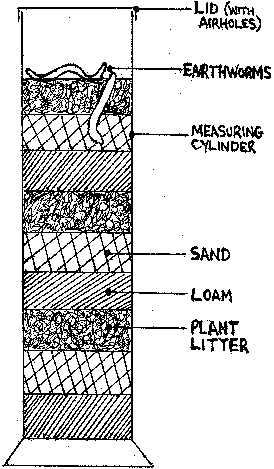![]() ...BACK to Microbes &
Co-operation... CONTENTS
...FORWARD
to Ecosystems connected..
...BACK to Microbes &
Co-operation... CONTENTS
...FORWARD
to Ecosystems connected.. ![]()
![]()
6. PLANTS AND WORMS IN THE SOIL
6.1 DEMONSTRATION: Worms mix the soil
This is a demonstration for the group, which shows the action of earthworms in the soil.
Materials
One large, transparent measuring cylinder or tall, thin jar (e.g. 6cm diameter x 40cm height).
Two visually distinct types of soil (without large clumps), e.g. light
brown sand and dark brown loam.
Small, broken up pieces of plant litter, e.g. grass clippings or fallen leaves.
Water
Five strong, energetic earthworms (if your cylinder is small, use fewer worms).
A small amount of card
Scissors
Sellotape
Procedure
Into the cylinder, repeatedly add 3cm layers of the soils and plant litter, in turn, until three-quarters full. If the soils are very dry, add around one fifth of the cylinder's volume in water. Add less if they are not so dry. Once fully absorbed, add the earthworms. Make a cap from the card, pierce half-centimetre airholes, and stick firmly over the top.

Over a few days, or longer, the worms will move through and consume the soil and litter, mixing the distinct bands together. While this takes place, the following group experiment can be performed...
![]()
6.2 EXPERIMENT: The effects of soil drainage on plants
This experiment is performed to show that both too little and too much water can kill plants. A balance is needed for plants to remain healthy. The experiment uses only one type of soil, imposing different degrees of drainage. It is intended to model soils of different particle size, and their resultant drainage rates. Different soil types are not used in the experiment, as it would take too long to produce results.
Materials
Six two-week old, healthy wheat plants, in standard soil and pots (around 10cm diameter) with drainage holes [Different plant species may be used, though they must be fairly water-sensitive].
Two pots or bowls, without drainage holes, of around the same height as the plant pots and 5cm wider.
Measuring jug
Large tray
Water
Procedure
Put plants 3 and 4 into second pots and all six plants on the tray, in adequate daylight. Using the blank results table provided (W7), record details about the health of the plants. Add 50ml of water to each of plants 1 to 4, allowing the plants without outer pots to freely drain. Empty any water from the tray. Repeat daily. [The plants should be able to survive weekends without being watered, if nobody is available to do so].
| PLANT |
OUTER POT? |
WATER? |
|
1 & 2 |
no |
yes |
|
3 & 4 |
yes |
yes |
|
5 & 6 |
no |
no |

Expected outcome
Because it cannot drain away, water will build up in the outer pots, making the soil constantly waterlogged. After a week or two, the plants with outer pots will show clear signs of sickness, e.g. yellowing and drooping of leaves. The unwatered plants will also become sick. The other plants should be healthy.
Each day, a different pair of children can take responsibility for making recordings and watering the plants. Part of the worksheet (W6) is to be completed at the start of the experiment, and the remainder at the end.
The experiment should imply that when soil drains too quickly (modelled by plants 5 and 6), plants become unhealthy. Such fast drainage occurs when soil particles (and their gaps) are too large. However, slow drainage (modelled by plants 3 and 4), can also be harmful. This occurs when particles (and their gaps) are too small. It is usually best for plants if the soil has a mixture of sizes (modelled by plants 1 and 2). This mixture of soil is provided in the ecosystem by the action of animals such as earthworms.
![]()
![]() ...BACK to Microbes &
Co-operation... CONTENTS
...FORWARD
to Ecosystems connected..
...BACK to Microbes &
Co-operation... CONTENTS
...FORWARD
to Ecosystems connected.. ![]()
![]()